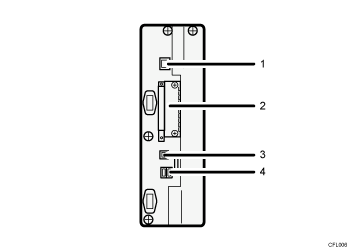Connecting to the Interface
This section explains how to identify the machine's interface and connect the machine according to the network environment.
![]()
The standard Ethernet and USB2.0 ports are not available when the Gigabit Ethernet board is installed into the machine. Use the Ethernet and USB2.0 ports on the Gigabit Ethernet board.

10BASE-T/100BASE-TX port
Port for connecting the 10BASE-T or 100BASE-TX cable
Optional board slot
Install an optional interface board in this slot.
The slot can accommodate the file format converter or one of the following interface boards:
Wireless LAN board: Required if you want to connect this machine to a wireless LAN. When installed, this unit allows you to connect the machine to an IEEE 802.11 a or IEEE 802.11 b/g wireless LAN.
Gigabit Ethernet board: Required if you want to connect the machine to a network using a 1000BASE-T, 100BASE-TX, or 10BASE-T cable.
USB 2.0 [Type B] port
Port for connecting the USB2.0 [Type B] interface cable
USB Host Interface
Port for connecting the USB interface cable
Use this interface to connect the machine to a card authentication device.
![]()
The optional interface board slot can contain one module only: You can install only one wireless LAN board, one Gigabit Ethernet board, or one file format converter at a time in this slot.
Related topics
Connecting to the Ethernet InterfaceConnecting to the Ethernet Interface
Connecting to the Gigabit Ethernet Interface
Connecting to the Gigabit Ethernet Interface
Connecting to the USB (Type B) Interface
Connecting a Device to the Machine's USB Host Interface
Connecting to the Wireless LAN Interface

